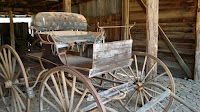So today's choice was a drive to Sofala, and to Hill End. The gold mining areas along the Turon Rivers. It was also the home of Margaret Durnford nee McConnell, and her second partner, George Bills, and our first great aunt, Charlotte Durnford, and their two children William and John Bills.
Now there are some holes still in this research, but as any family historian will tell you, research is never ending.This part was able to be put together thanks to some poems that Charlotte wrote, regarding the area of Sofala.
What struck me was the distance from Bathurst to Sofala. It must have taken them forever to travel the bush tracks. This area is close to the Woolambi Forest, where the Woolambi pine was found not so long ago.
At couple of photo stops along the way.





We stopped for morning tea at the Old Sofala Gaol, which I felt was appropriate, given the aliases that Montague Durnford had, over time.
It is also full of collectibles.

Gold was first discovered in 1851, and very soon afterwards there were more than 20,000 miners on the site. The town stretched for 16 kilometers along the banks of the Turon River, with over 40 pubs in existence.
Lots of photos and memorabilia, some photos just didn't turn out too well, but no mention of the Bills family of miners.
 |
| Inside the gaol cell! |
There are walking tours around the town, but it was just so cold and windy that we opted to drive the distance. First we came across the St Joseph's Catholic School opened in 1868. Perhaps Charlotte attended this school, the building was certainly beautiful, and Mary McKillop visited when doing her trip with Bishop Quinn

 "During her visit to see Bishop Quinn in Bathust from 23 to 30 January 1876, Mary MacKillop traveled by coach to Wattle Flat on the Peel Rd to Sofala,
"During her visit to see Bishop Quinn in Bathust from 23 to 30 January 1876, Mary MacKillop traveled by coach to Wattle Flat on the Peel Rd to Sofala, Across the road was the Christ Church Anglican Church. Margaret was buried at the Christ Church cemetery in Newcastle, so the family may have had links to this church,.
 The are a lot of old graves and headstones, but almost impossible to read any of them. Long grass and an uncared for block, which perhaps, we felt, could be improved by having a list of all those buried supplied on a board, thus increasing the interest of ancestors such as ourselves.
The are a lot of old graves and headstones, but almost impossible to read any of them. Long grass and an uncared for block, which perhaps, we felt, could be improved by having a list of all those buried supplied on a board, thus increasing the interest of ancestors such as ourselves.The state public school opened in 1878.
Of interest there was a name panel in the Memorial Park, listing the names of the residents residing in 2001. No Bills family were mentioned.
 In 1862, the Royal Hotel opened and it is the only one operating today. From the map of the Turon Goldfields, there were approximately 40 different mining sites along the Turon River.
In 1862, the Royal Hotel opened and it is the only one operating today. From the map of the Turon Goldfields, there were approximately 40 different mining sites along the Turon River.We then drove to Hill End. From research, I was aware that there was an area called Bald Hills, and the largest gold nuggest was found there.
A visit to these towns, ensures a great admiration of the hardships that our grandparents endured. First stop was the Visitor Information office, but it closed for lunch at 12.30pm. So down to the town for a walk around, and it was bloody cold and windy.
A very old town, or part of a town, made all the better thanks to a enterprising businessman, who in 1870's took hundreds of glass plate photos, which were found in 1950. The photos have then been printed onto panels, which have been erected on the location where a building had previously been. This provided a fantastic insight into life as it was, and we could very well have been part of the gold fever of 150 years ago.







Lunch was at the Royal Hotel, (another one) and once again more than 40 pubs were operating in the gold days.




After lunch back to the Visitor Information centre, in the old hospital. But it must have been too cold because they did not return from lunch!
How to avoid the rough road, just bring your helicopter! As you do, mind you the winds would have not made the trip very comfortable, they are around 40mph.






































No comments:
Post a Comment